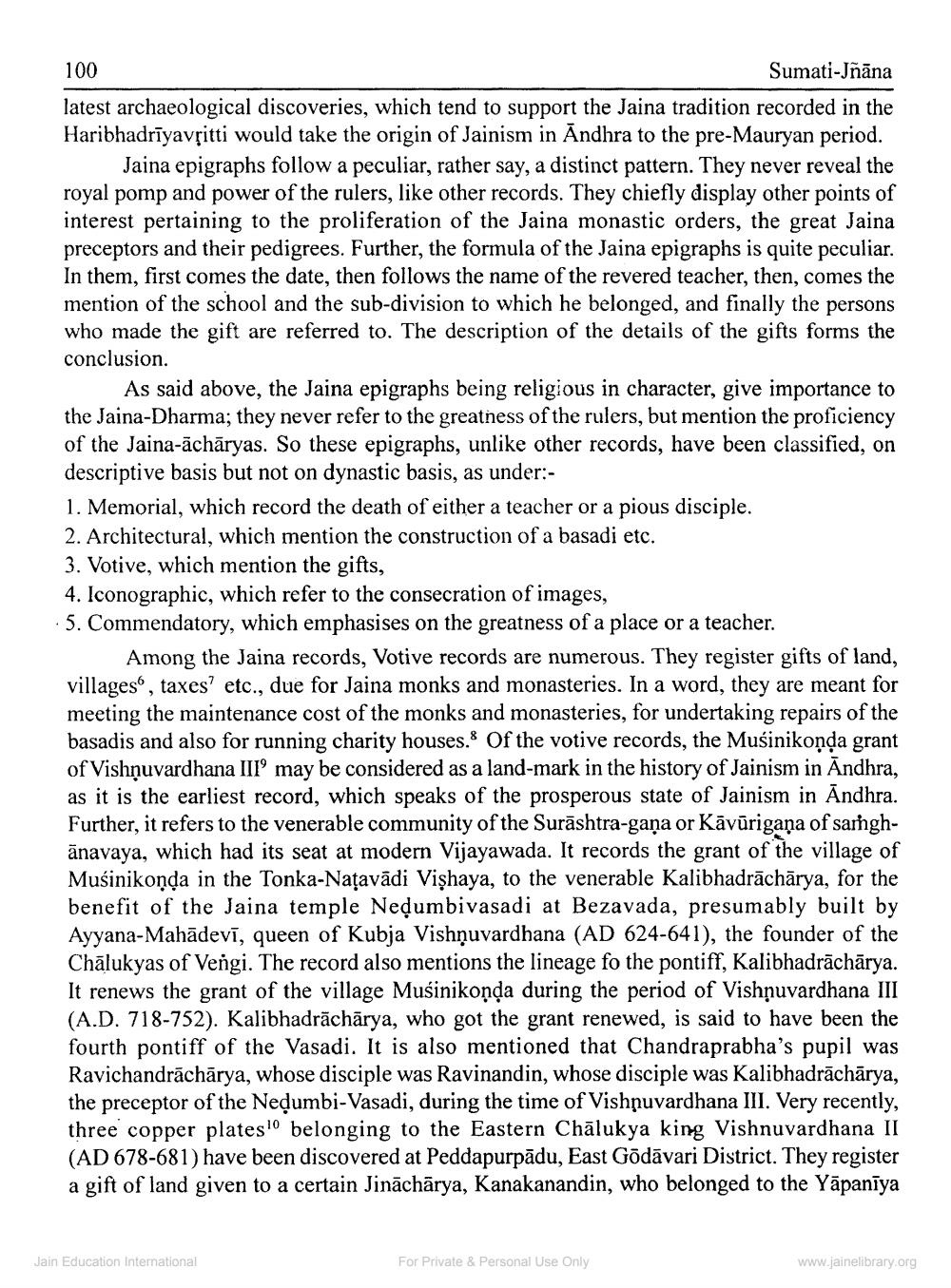________________
100
Sumati-Jñāna latest archaeological discoveries, which tend to support the Jaina tradition recorded in the Haribhadrīyavșitti would take the origin of Jainism in Andhra to the pre-Mauryan period.
Jaina epigraphs follow a peculiar, rather say, a distinct pattern. They never reveal the royal pomp and power of the rulers, like other records. They chiefly display other points of interest pertaining to the proliferation of the Jaina monastic orders, the great Jaina preceptors and their pedigrees. Further, the formula of the Jaina epigraphs is quite peculiar. In them, first comes the date, then follows the name of the revered teacher, then, comes the mention of the school and the sub-division to which he belonged, and finally the persons who made the gift are referred to. The description of the details of the gifts forms the conclusion.
As said above, the Jaina epigraphs being religious in character, give importance to the Jaina-Dharma; they never refer to the greatness of the rulers, but mention the proficiency of the Jaina-achāryas. So these epigraphs, unlike other records, have been classified, on descriptive basis but not on dynastic basis, as under:1. Memorial, which record the death of either a teacher or a pious disciple. 2. Architectural, which mention the construction of a basadi etc. 3. Votive, which mention the gifts, 4. Iconographic, which refer to the consecration of images, . 5. Commendatory, which emphasises on the greatness of a place or a teacher.
Among the Jaina records, Votive records are numerous. They register gifts of land, villages, taxes etc., due for Jaina monks and monasteries. In a word, they are meant for meeting the maintenance cost of the monks and monasteries, for undertaking repairs of the basadis and also for running charity houses. Of the votive records, the Mušinikonda grant of Vishņuvardhana III may be considered as a land-mark in the history of Jainism in Andhra, as it is the earliest record, which speaks of the prosperous state of Jainism in Andhra. Further, it refers to the venerable community of the Surāshtra-gaña or Kāvūrigana of sainghānavaya, which had its seat at modern Vijayawada. It records the grant of the village of Muśinikonda in the Tonka-Națavādi Vişhaya, to the venerable Kalibhadrāchārya, for the benefit of the Jaina temple Nedumbivasadi at Bezavada, presumably built by Ayyana-Mahādevī, queen of Kubja Vishnuvardhana (AD 624-641), the founder of the Chālukyas of Vengi. The record also mentions the lineage fo the pontiff, Kalibhadrāchārya. It renews the grant of the village Musinikonda during the period of Vishnuvardhana III (A.D. 718-752). Kalibhadrāchārya, who got the grant renewed, is said to have been the fourth pontiff of the Vasadi. It is also mentioned that Chandraprabha's pupil was Ravichandrāchārya, whose disciple was Ravinandin, whose disciple was Kalibhadrāchārya, the preceptor of the Nedumbi-Vasadi, during the time of Vishnuvardhana III. Very recently, three copper platest belonging to the Eastern Chālukya king Vishnuvardhana II (AD 678-681) have been discovered at Peddapurpādu, East Gödāvari District. They register a gift of land given to a certain Jināchārya, Kanakanandin, who belonged to the Yāpaniya
Jain Education International
For Private & Personal Use Only
www.jainelibrary.org




